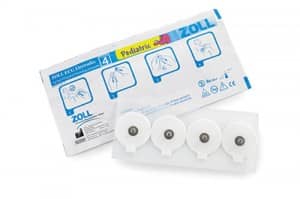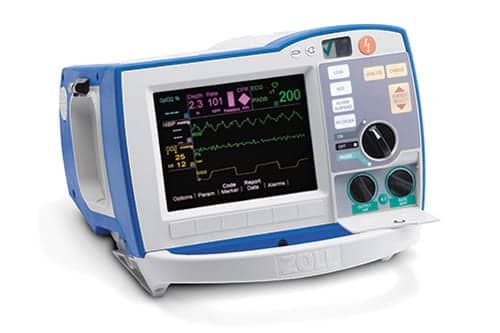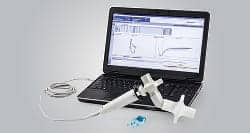Given the unique anatomy of pediatric and neonatal lungs and the inherent frailties associated with them, extra care is required of clinicians when resuscitating this population.
Since the introduction of external electrical stimulation of the heart more than 60 years ago, the art of resuscitation has undergone a significant evolution, saving lives in the process. The American Heart Association reports that cardiopulmonary rescue efforts save approximately 92,000 people each year. From the handheld bag valve mask (BVM) to technologically advanced devices, more resuscitation options currently exist for a range of patient populations.
Quality Matters
Clinical hospital personnel have all been trained in resuscitation techniques and follow a facility’s protocols. But the quality of CPR provided during resuscitation may ultimately affect the outcome, according to Deborah Leahy, director of North American Hospital Marketing at Zoll Medical Corp. “And high-quality CPR is difficult to achieve,” she noted. A 2015 study1 found a 25% increase in survival rates following cardiac arrest when high-quality CPR is initiated.
CPR feedback technology on the market is intended to help the rescuer through the resuscitation process. For instance, Real CPR Help tells the rescuer if compressions are deep and fast enough with the proper release in order to achieve good blood flow. A 2013 study2 showed that advanced CPR technology, together with audio-visual feedback, increased the patient survival rate nearly threefold.
To optimize outcomes, the American Heart Association (AHA) recommends minimizing the number of interruptions while giving chest compressions.3 A technology like Zoll’s See-Thru CPR filters out artifact from compressions in the patient’s electrocardiogram (ECG), allowing the user to see the underlying heart rhythm and decreasing pause time during CPR, according to Leahy. “The longer you’re off the chest, the more time the blood has to drain from of the heart. Defibrillation is most effective on a perfused heart.”
Another proven technology is an impedance threshold device (ITD), a noninvasive device that lowers intrathoracic pressure during the recoil phase by selectively restricting unnecessary airflow into the chest. It doubles blood flow to the heart and improves blood flow to the brain by 50%, according to Leahy.
Resuscitation devices also extend beyond the hospital walls. Post-cardiac arrest patients discharged to the community have access to wearable technology in the form of a LifeVest equipped with an alarm. Leahy noted that should the patient have another cardiac episode, this could become a lifesaving device. “If the patient is conscious, he can push a button to turn the device off. If the patient is unconscious, the device will deliver a shock immediately if needed,” she said. “Early defibrillation increases the chance for survival.”
BVM vs T-piece
Steve LeCroy, MA, CRTT, EMTP, clinical manager, national distribution at Mercury Medical, explained that the bag valve mask (BVM) has become a standard resuscitation technique, but noted that while the device is quite basic, effective operation requires some skill. “You hold the mask on the face with one hand and squeeze the bag with the other. It’s easy to explain this, but hard to do. You have to get a good seal on the patient’s face. This is especially difficult when a patient has no teeth or has a beard,” he said. “It’s very difficult to do effectively. We are advocating for two people to do this. You need a lot of hands-on experience,” he said.
LeCroy pointed out that the T-piece resuscitator, which was created in the late 1980s for use in neonates, has been found to be safer and easier to use. “I could demonstrate how to use the T-piece in two minutes. Instead of holding a mask, you put your finger over the hole and watch for the chest rise and [observe] the gauges, which are set. You are not holding the mask and squeezing the bag at the same time,” he said.
Current standard recommendations are 25/5 peak inspiratory pressure/positive end expiratory pressure (PIP/PEEP) flow of 12 as a starting point with blended gas at 21% FiO2, LeCroy noted. “With a bag valve mask it’s impossible to meet the neonatal resuscitation guidelines, with or without a manometer. If you don’t work in the NICU or labor and delivery, you do not have many opportunities to bag babies.”
Neonatal Challenges
As noted, newborn resuscitation requires careful attention to pressure and volume due to the delicate nature of babies’ lungs. David Hendrickson, neonatal product manager for Fisher & Paykel, said that in many cases the neonate’s airway is somewhat closed and the resuscitation process has a risk of “shearing” the lungs. Even if airways are open, they can collapse easily due to surfactant deficit in babies less than 27 weeks gestation, he pointed out. “[Also] during the last trimester a baby uses the intercostal muscles and diaphragm to breathe. At birth the baby could have some paralysis or not enough muscle tone to deliver positive pressure,” said Hendrickson.
Much debate has surrounded the use of the bag valve mask versus the newer T-piece, which provides controlled target PIP and consistent PEEP, helping functional residual capacity (FRC) and improving lung function, even though a branch study3 found the T-piece to be safe and effective as other techniques.
“Years ago a bag and mask was standard treatment, but research in the last 20 years finds that babies need PEEP to recruit the lungs,” Hendrickson said, noting that the bag valve mask requires a more subjective approach. “[Most hospitals] want to make the T-piece standard, but keep the bag and mask available in case there is a need. From a neonatal point of view, the doctors want the T-piece in the NICU beds. We are not just bringing babies back to life, but supporting their respiratory systems.” A 2011 study4 examined a self-inflating bag, a flow-inflating bag and a pressure-limited T-piece and found the latter provided consistent PIP.
In spite of the research, many students still prefer the bag and mask, reporting that they feel compliance of the lung better when using this technique. But Hendrickson asserted that with an airway as small as an infant’s, it’s challenging to feel compliance. “A lot of factors impact the effectiveness of the bag and mask,” he said, citing fatigue and staff turnover as two important issues.
Pediatric Population

The T-piece, which currently is exclusively for neonates, does not factor into resuscitation for pediatric or adult patients. Typically, the BVM is the device of choice for these two populatins. However, the original simple device has evolved and now comes with a number of options, depending on patient need. “[The bag valve mask] has an ala carte-style menu,” Hay said. “As we get into more exotic, more automatic forms of resuscitation it requires more adjunct involvement.” He pointed out that manual resuscitation devices are still widely used not only in a hospital setting but can also be found on the streets, in restaurants, at the gym and other public spaces.
Leahy reported, “Zoll is the only provider with a focus on providing solutions to address pediatric resuscitation. We have the only CPR solution for pediatric use and the only crash cart defibrillator that has a pediatric-specific rhythm analysis in AED mode. The resuscitation solution is integrated within the electrodes. It’s easy to use and ready to go. It’s also disposable, reducing the potential for hospital-acquired infections.”
Pushback
Hay noted that when first released the T-piece resuscitator was touted as the greatest automatic device, allowing the user to set a couple of parameters and enabling almost anyone to resuscitate a child or infant after 30 seconds of discussion. “At face value it is easy to use,” he said. “But I did T-piece training and was amazed that people were reluctant to adopt it because it requires everybody to have a different process in setting parameters. The goal is to get everyone involved in the process. They have to become unconsciously competent,” he said.
The main reason facilities are reluctant to change relates to the nature of the resuscitation product itself, said Hay. “A standard bag valve mask is in every room. It’s no small task to completely do an overhaul and change to new resuscitators. It requires buy-in from numerous different people and departments,” he said.
Tim Gallagher, product expert at CareFusion, agreed that resuscitation devices have become more complicated with added features, such as disposable CO2 detectors, manometers and expiratory filters that protect the clinician from contracting a patient’s illness. Moreover, hospitals have several options when it comes to purchasing the devices, from prepackaged with all accessories in one kit to individual pieces. “But cost considerations come into play. Customers ask themselves if they need all the different options for every single case or would it make sense to buy them separately and use as needed,” he said. “They have to decide internally what is best for the patient, which option makes the clinician’s life easier and consider the cost.”
Hospitals also continue to debate the value of disposable versus non-disposable devices. LeCroy pointed out that the final decision often depends on the clinical environment. Non-disposable devices require cleaning and maintenance and capital investment up front, while disposable circuits constitute an ongoing cost. “Most hospitals can’t afford one for every bed, but they could put a bag valve mask in every room,” he said. “The medical world is moving toward disposable equipment because of infections and mandates from the Affordable Care Act.” RT
Phyllis Hanlon is a contributing writer to RT. For further information, contact [email protected].
SIDEBAR: Critical Care Resuscitation Unit Speeds Transfer of Critically Ill Patients
A year after implementing a specialized program to expedite the transfer and admission of critically-ill patients requiring surgery, the University of Maryland Medical Center (UMMC) has reported sharp increases in the number of transferred patients while at the same time dramatically cutting transfer times and time to surgery.
According to research5 published in the Journal of the American College of Surgeons, UMMC’s new Critical Care Resuscitation Unit (CCRU) helped “significantly” decrease median arrival times for transferred patients, from 223 to 118 minutes, and reduced median time to surgery from about 57 hours to about 18.5 hours. In addition, median hospital length of stay (17 vs 13 days) and patient mortality (16.5% vs 14.6%) each declined from 2013 to 2014.
“The key finding is that creating a process equaled change,” lead investigator Thomas Scalea, MD, of UMMC said in a news release. “In this particular case, the major variable is time—time to get patients in, time to get patients through the process.”
Before implementing the program, UMMC had been losing admissions of critically ill patients because it did not have available beds in the hospital ICU. “Our ICU beds were full of sick people,” Scalea said. “The referring hospitals, particularly if people are sick, do not want to wait for a bed; they want you to come right away and pick the patient up.” So referring hospitals in the UMMC service area would call multiple high-volume institutions and send that critically ill patient to the first center that had a bed available.”
The challenge for UMMC was to develop a fast-intake strategy for these critically ill patients that side stepped the emergency department. “Emergency departments are not good places to use for incoming critically ill transfers,” Dr Scalea said. “It’s not what they do well.”
In response, UMMC developed its CCRU program, establishing a six-bed ICU in its Shock Trauma Center. As part of the unit, an attending intensivist staffs the CCRU around the clock and directs patient throughout assessment and stabilization process. The CCRU staff and subspecialists collaborate to rapidly evaluate and stabilize patients and then transfer them to the unit or operating room that will best serve their needs.
In the year after the CCRU opened, overall transfers increased 64.5% and those of critically ill surgical patients increased 93.6%, along with the aforementioned cuts in transfer times and time to surgery — both important when working with time-sensitive diseases like stroke, hemorrhage, and more. “The demand for transfers has gone way up,” Scalea said. “It raises a number of questions, among them, how do you get the transferred patients into your institution? One thing the institution needs is a bed and also a process to get people in.”
The CCRU is a hybrid of sorts, Scalea said, in that it brings together the rapid evaluation and stabilization of patients that an emergency department performs with the longitudinal care that an ICU offers. UMMC recruited emergency physicians who are fellowship trained in critical care to staff the CCRU “because they have the mindset of rapid evaluation and transfer to the operating room or a different ICU or another appropriate setting where the patient needs to go,” he said.
“I think that departments of surgery should be very interested in this concept. There was a clear benefit to the department because they performed more vascular, cardiac and emergency general surgery operations.”
References
-
Yannopoulos D, Aufderheide TP, Abella BS et al. “Quality of CPR: an important effect modifier in cardiac arrest clinical outcomes and intervention effectiveness trials.” Resuscitation. Sep 2015;94:106-13. doi: 10.1016/j.resuscitation.2015.06.004. Epub 2015 Jun 12.
-
Bobrow BJ, Vadeboncoeur TF, Stolz U et al. “The influence of scenario-based training and real-time audiovisual feedback on out-of-hospital cardiopulmonary resuscitation quality and survival from out-of-hospital cardiac arrest.” Ann Emerg Med. July 2013;62(1):45-56.e.l.
-
Berg RA, Hemphill R, Abella BS et al. “Part 5: Adult basic life support: 2010 American Heart Association Guidelines for Cardiopulmonary Resuscitation and Emergency Cardiovascular Care.” Circulation. 2010;122(suppl 3):S685–S705. Hawkes CP, Ryan CA, Dempsey EM. “Comparison of the T-piece resuscitator with other neonatal manual ventilation devices: a qualitative review.” Resuscitation. 2012 Jul;83(7):797-802. doi: 10.1016/j.resuscitation.2011.12.020. Epub 2012 Jan 4.
-
Klingenberg C, Dawson JA, Gerber A, et al. “Sustained inflations: comparing three neonatal resuscitation devices.” Neonatology. 2011; 100(1):78-84. doi: 10.1159/000322983. Epub 2011 Jan 26.
-
Scalea, T, et al. “Critical care resuscitation unit: an innovative solution to expedite transfer of patients with time-sensitive critical illness.” J Amer College of Surgeons. 2016 Feb 23. DOI: http://dx.doi.org/10.1016/j.jamcollsurg.2015.12.060










